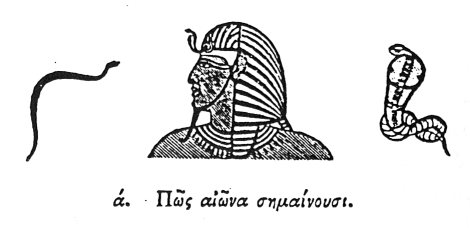
Masonic, Occult and Esoteric Online Library
The Hieroglyphics of Horapollo
By
How They Denote Eternity

To denote Eternity 2 they depict the SUN and MOON, because their elements are eternal. But when they would represent Eternity 2 differently, they delineate a SERPENT with its tail covered by the rest of its body: the Egyptians call this Ouraius, 1 which in the Greek language signifies Basilisk: 2 And they place golden figures of it round the Gods. The Egyptians say that Eternity is represented by this animal; because of the three existing species of serpents, the others are mortal, but this alone is immortal; and 3 because it destroys any other animal by merely breathing upon 4 it even without biting. And hence, inasmuch as it thus appears to have power over life and death, they place it upon the head of the Gods.
Footnotes
I. Denotes Eternal.
II. Head of a God with the Basilisk upon it. The basilisk often passes over the head, and is occasionally found passing round it.
III. Denotes Immortality.—Sharpe, 186, 191.
5:2 Eternal power?—a definite period?—an age?
6:1 ΟΥΡΟ, in Coptic, signifies a king. Jab. Champ. Tat.—Morell suggests Ο?βα?ος, as a derivative from ???, Ob, a serpent.
6:2 The Cobra Capella.—Hasselquist is in error when he says that the Arabs call this serpent Haje. They call it Nasher: and Haiyeh or Hayyeh is a general name for a serpent.
6:4 Kircher suggests, "By the hiss."—See also Sanchoniatho Eus. Pr. Ev. lib. i. c. 10.
6:3 Qy. insert" Power?"
